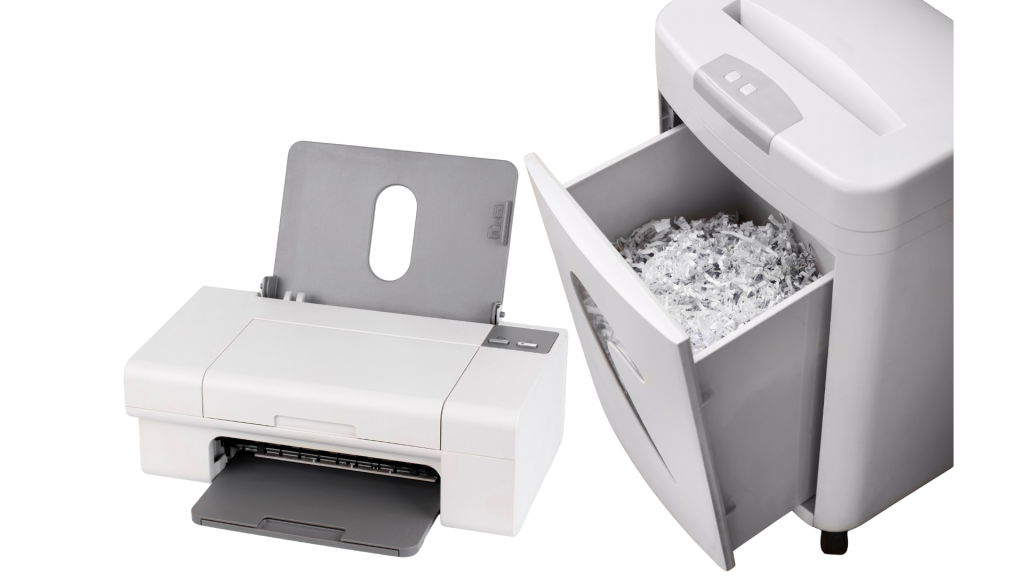
Going paperless seems difficult, especially when you don’t know where to begin. The best place to start is to define a clear and actionable goal. Thereafter, setting a timeline would help speed up the process. These tips would help give direction and simplify the process of going paperless. We hope these tips will help you on your journey to going paperless.
Key Takeaways
- Going paperless is a mindset shift.
- Embrace the digital tools to minimize paper use.
- Ensure complete digital document security and disaster recovery through having backups.

Find Tools to Manage your Confidential Information
Find the right Tools to Manage your Confidential information.
Digital Scanners – Assess and Choose the right scanner for your needs.
Document Shredders – Choose a document shredder that works for you to ensure your information is safe.
Planning and Mindset shift
- Setting a goal to go paperless with a timeline. This will help in initiating and give direction to the team. They will be able to know what to expect and when to finish.
- Getting leadership buy-in. Leaders not being on board will slow down the process. For the team to embrace the change, the leaders have to walk the talk, which is to show by example that it is doable.
- Conducting a paper audit. By the time the company plans to go paperless, it must have been using paper documents before. And if they didn’t have a retention policy in place, this means they have been storing all the paper documents they have produced. A paper audit would be required to separate the documents that are still required from the ones which are no longer required. The paper documents that are no longer required can then be disposed of in a confidential and environmentally friendly process. The ones still required can be digitized and stored in the cloud.
- Setting rules for why and when paper documents will be used. This will help control the amount of paper being used on a daily basis. And if possible, it should reach a point where paper documents are not produced at all, apart from inbound. The inbound paper documents can be digitized on receipt.
- Educating the team on the benefits of going paperless. This can be broken down to benefits to the company and to them as individuals. This can speed up their work or even reduce their workload. And also reduce costs and improve productivity for the company.
- Create a digitization policy. This will help give direction to the team on how to manage the inbound paper documents and minimize the paper documents coming into the company.
- Make your approach “digital first”. This is to discourage the printing of paper documents, which have always been printed, and encourage digital storage. This can be included in the digitization policy.
- Sharing success stories with the team on other companies that have succeeded would motivate them and help speed up the process.
- Buying a scanner depends on your needs and budget. Different scanners are used for different needs. For example, the smartphone app or portable scanner can be used for scanning documents on the move. Scanning documents immediately on receipt. High-speed digital scanners are used for bulk digitization where paper documents have accumulated over time. The desktop scanner can be used for everyday scanning of paper documents being received into the office continuously.
- Scanning and capturing archived paper documents is appropriate so as to discard the old paper documents that are occupying a sizable space of the office. This can then be stored in the cloud and made searchable using the OCR software.
- Automatic scanning process set up for incoming mail helps minimize or eliminate inbound paper documents. This would also be used for the immediate digitization of receipts and invoices as soon as they are received.
- A well-organised digital filing system with a standardized file naming convention is appropriate for ease of search and retrieval. All scanned documents are uploaded into this digital repository for ease of access.
- The use of OCR software will ease document search for immediate access.
- Disposing of the paper documents immediately after digitization would be appropriate. If possible, this can be done through shredding to protect the confidential information and also environment.
Managing and storing digital documents
- Digital storage, Budget, the size of the company and the quantity of documents will determine the digital storage. For a small company, Google Drive, Dropbox or OneDrive. Medium to large Enterprises can opt for an Electronic document management system with the option of a Proprietary EDMS or open-source EDMS.
- A clear folder structure in place will ensure that document accessibility is easy. This includes the use of tags and metadata to improve searchability.
- Retention policy is appropriate in managing your digital documents. This helps in decluttering by the deletion of documents that have passed the retention period and archiving outdated files.
- A backup system is put in place to prevent data loss.
- Additional security, such as encryption, is needed to protect the sensitive documents.
- Version control to ensure tracking of document changes is in place.
- Automation of the file organization will improve the workflow process and increase efficiency.
Digital communication
- Use voice-to-text apps for note-taking capture.
- Team collaboration and meetings can be done using shared digital platforms and documents.
- Use of electronic whiteboards for brainstorming sessions.
- Meeting Agendas and minutes can be stored in digital folders.
Digital Financial Management
- Use of digital accounting systems software, for example, QuickBooks, Xero, will help speed up the process. These will speed up reporting and manage reconciliation digitally.
- Discouraging the use of paper receipts and increasing the use of electronic receipts will help speed up the transition process.
- Increase the use of digital invoicing and payments. Since all these are created digitally, producing them in the next step in paper format can be eliminated.
- Financial reporting can be automated through the use of accounting tools to discourage manual reporting.
- Discourage the use of paper cheques and use online bill payments instead.
- Use of electronic payroll systems to eliminate paper pay slips.
- Use of legalized electronic signatures for financial approvals.
- Email notifications for bank transactions would be appropriate.
Meetings and Collaborations
- Encourage the use of tablets instead of notebooks to reduce paper use. Digital agendas and meeting summaries are shared digitally.
- Use of digital whiteboards and cloud-based workspaces for the team.
- Use of collaboration tools like Zoom, Microsoft Teams and Google Meet.
Electronic Signatures (E-Signature) and Paperless Contracts
- Encourage the use of e-signatures, such as Docusign, Adobe Sign etc, to reduce the need for printing paper documents to append a signature. The e-signature has to comply with the regular requirements.
- Ensure all contracts and agreements are digitized. Create digital templates for common agreements and contracts which when signed digitally are then stored in a secure cloud storage.
- The team undergoing training on how to handle digitally approved documents will streamline compliance.
- Workflow automation for approvals will ensure efficiency in the paperless space.
- Regular review and update of electronic document policies will keep the processes flowing.
Reduce Paper usage
- Set up rules on when and why printing should be done. This will ensure printing is done only when necessary.
- Use of digital receipts instead of physical receipts to eliminate paper use.
- Request for electronic statements from the banks and service providers.
- Use digital invoices and payments.
- Sort and digitize the old paper files which are still in use and dispose the ones no longer in use through shredding.
- Scan and store incoming physical mail immediately on receipt.
- Encourage the use of digital learning materials, magazines and newspapers.
Automate Workflows
- Replace paper-based processes with automated workflows.
- Implement digital approval and optimization of internal processes with a digital workflow.
- Integrate all the digital tools within the company to eliminate manual data entry.
Security and Compliance
- Implement access control to ensure only authorized personnel can access sensitive documents.
- Encryption of all confidential documents. This is to protect your information in the documents.
- Regular software updates to prevent data breaches.
- Have a backup of all the digital documents to prevent data loss.
- Audit document access and usage regularly.
Conclusion
Using these simplified tips within a timeline will help you move a long way towards having a paperless workspace.